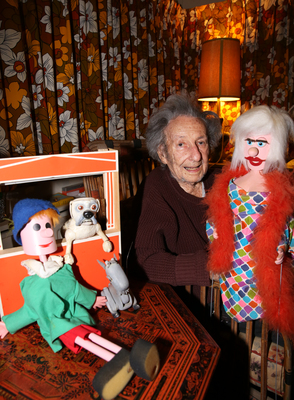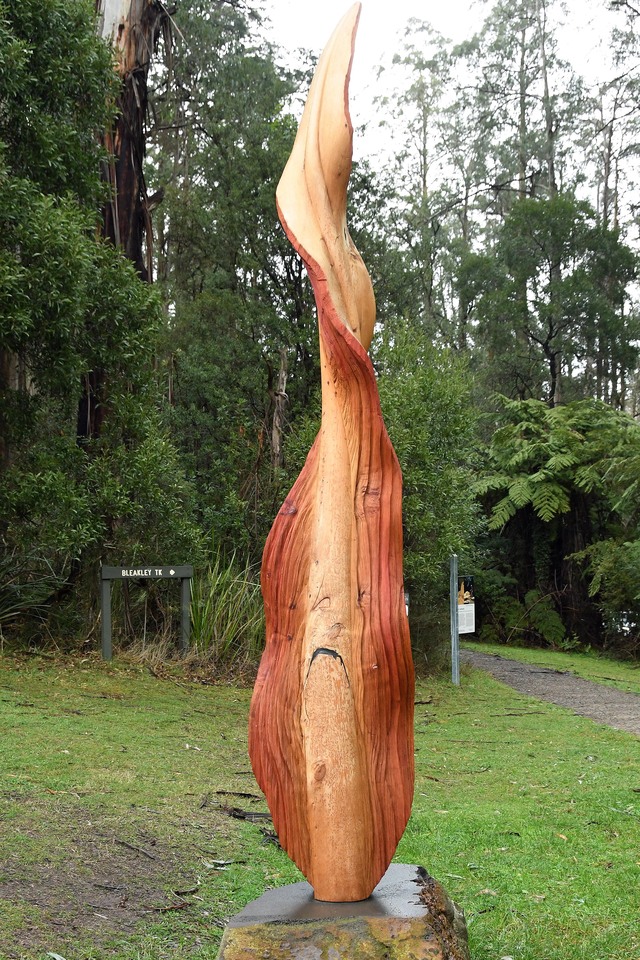By Derek Schlennstedt
He’s arguably the most famous puppet in Australia. That memorable pink oval feathered body, who on Saturday nights would charm viewers with his wit and cheek.
He is none other than that ostentatious ostrich named Ossie who Australians have fallen in love with.
And although Darryl Sommers and Ernie Caroll became names synonymous with the show and the big headed bird, one name went unseen. Axel Axelrad, a 97-year-old Olinda resident, who despite creating the most notorious puppet Australian television has ever seen has gone largely unnoticed.
“That Ossie Ostrich wasn’t meant to be a great puppet, it was just something to make … it became Ossie Ostrich because of the people that bought it,” Axel said.
At his house in Olinda, there are still remnants of a life that saw Axel become responsible for many of the well-known characters that were seen on Australian TV in the late 1900s.
The Magic Circle Club, Adventure Island, the dog from Young Talent Time, Tuckerbag, and, of course, Ossie Ostrich from Hey Hey it’s Saturday were all made from Axel’s wonderful imagination.
And that imagination, he said, was where it all began.
“I get amazingly wild ideas sometimes- that’s half the trouble you see.”
Migrating to Australia in the 1950s from Germany, Axel came to Australia as a qualified aeronautical engineer, inspecting plane parts and ensuring that they were in order- a job he said he quickly became bored with.
During this time, while he and his wife were living in South Yarra he began to make puppets; a skill which he had been taught at school in Germany and a hobby which he had never considered as a career.
“I had a hobby, making puppets, but I only made a couple for me and some friends; it wasn’t a business,” he said.
Selling them to local gift shops in South Yarra, Axel slowly began to grow his small puppet business until most of the stores on his street stocked them.
In the 1950s, Axel said, Australia was not considered ‘a puppet country’ and this helped him as there was a large demand for puppets, but no supply.
“Australia was not a puppet country – there weren’t any puppet makers here.”
“There was a demand for puppets, but there was nobody making puppets. There were some hobbyists, but hobbyists stick too much on a puppet by which time the puppet is so expensive, you can’t sell it.
“I thought I’ll find a system where the puppet is very simple and you can mass produce them.”
Having worked as an engineer, Axel drew from his experience and knowledge into the puppets he created. The sleek and functional puppets which he designed were easier and cheaper to produce, but they were still unique and different, and like the man himself, all had a lot of character in them.
“A puppet is quite simple; it’s like a human basically,” he said.
“They have a top part separated from the bottom part, but we decided to join the bottom and top together and then the arms and the legs are the same, only one is longer than the other.”
“I worked out how to make the least parts inside the puppet … it’s no good making the puppet complicated.”
“It was the standard design … You could make anything out of that.”
Leaving engineering behind him, Axel and his wife moved to Olinda at the end of the 1950s, and created the company Lamont Puppets where they began supplying their incredible range of puppets to toy stores all over the world including Europe, America and England.
When his puppets won Toy of the Year award, Axel and his wife would spend many of their nights and days, creating clothing for them or drawing the faces.
“We made 45,000 puppets; my wife did the clothing.”
“When the puppets won the Toy of the Year award, everyone wanted them.”
“At night, I sat in the corner, next to the heater doing the mouth, I’d also put the hair on or the hat … Sometimes it got a bit hectic, but we survived,” he joked.
Considered one of the pre-eminent puppet makers in Australia at the time, Axel began working with advertising companies and TV stations, and in the 1970s he created his most memorable work Oswald Q Ostrich.
Although Ossie was a ‘special’ puppet, Axel kept his design simple and was by this time a master at creating a realistic puppet without over complicating it. After receiving a call asking whether he could make an ostrich, he set to work.
A fibreglass ball and a cardboard tube covered in pink stretch cotton made up Ossie’s neck and head, and from that relatively simple construction, Ossie could effectively communicate a range of non-verbal expressions with just a tilt of his head or a curl of his beak. With that simple design, Ossie became an icon.
Although Axel created both Tuckerbag and Ossie Ostrich, he remains as humble as ever, and is glad that his creations were given life through television.
“If someone else uses them great, because I’m not a showman, I can’t remember dialogue … they wanted to have a puppet on television, and so they’d tell me what they wanted … I said I could make it,” he said.
“It was a combined action.”
“Somebody wanted something they can use, that can be remembered and that was it – I would make it for them … I was good at thinking of something different, outside of the box you see, which is what they needed … I’d get amazingly wild ideas and puppetry let me create those ideas.”







